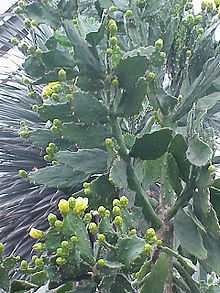Brasiliopuntia
| Brasiliopuntia | |
|---|---|
 | |
| Brasiliopuntia brasiliensis | |
| Scientific classification | |
| Kingdom: | Plantae |
| (unranked): | Angiosperms |
| (unranked): | Eudicots |
| (unranked): | Core eudicots |
| Order: | Caryophyllales |
| Family: | Cactaceae |
| Subfamily: | Opuntioideae |
| Tribe: | Opuntieae |
| Genus: | Brasiliopuntia (K.Schum.) A.Berger |
| Species: | B. brasiliensis |
| Binomial name | |
| Brasiliopuntia brasiliensis (Willd.) A.Berger | |
| Synonyms | |
|
Cactus brasiliensis Willd. | |
Brasiliopuntia is a genus in the cactus family, Cactaceae. It contains only one species, Brasiliopuntia brasiliensis.
It is found in Brazil, Paraguay, eastern Bolivia, Peru and northern Argentina, and has become naturalized in Florida among other places.[1]
Description
Brasiliopuntia brasiliensis shows thin, slightly shrunken cladodes on a central cylindrical trunk. The leaves are bright green.
White areoles bear one or two small brown upright spines.
Light brown flowers appear only on adult plants.
Systematics
Brasiliopuntia brasiliensis was placed in the genus Opuntia when the very broad genus Cactus was dismembered. The distinctive features of the species were recognized by Karl Schumann in 1898 when he created a subgenus Brasiliopuntia within the genus Opuntia. In 1926 Alwin Berger completed the separation from Opuntia by raising Brasiliopuntia to a full genus. A number of species have been described in the past, but are now considered only to be variants of B. brasiliensis.[1]
Species list
- Brasiliopuntia brasiliensis (Willdenow) A. Berger
Synonyms:
- Cactus brasiliensis Willdenow
- Opuntia brasiliensis (Willdenow) Haworth
- Opuntia bahiensis Britton & Rose
- Brasilopuntia bahiensis (Britton & Rose) A. Berger
- Opuntia schulzii A. Castellanos & Lelong
- Brasilopuntia neoargentina Backeberg
- Brasilopuntia schulzii (A. Castellanos & Lelong) Backeberg
- Brasilopuntia subcarpa Rizzini & A. Mattos
References
| Wikimedia Commons has media related to Brasiliopuntia. |
Bibliography
- Innes C, Wall B (1995). Cacti Succulents and Bromaliads. Cassell & The Royal Horticultural Society.
External links
- (English) photos on www.cactiguide.com